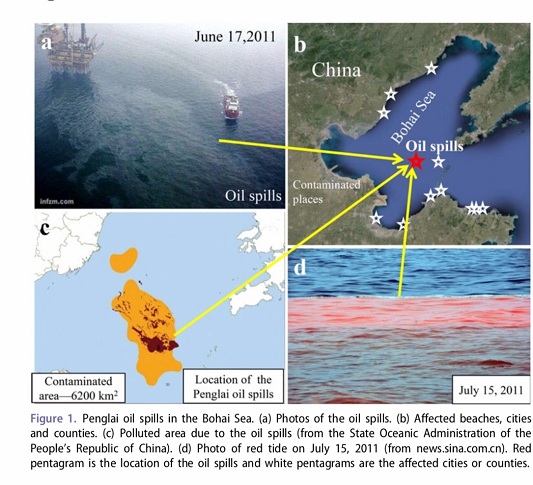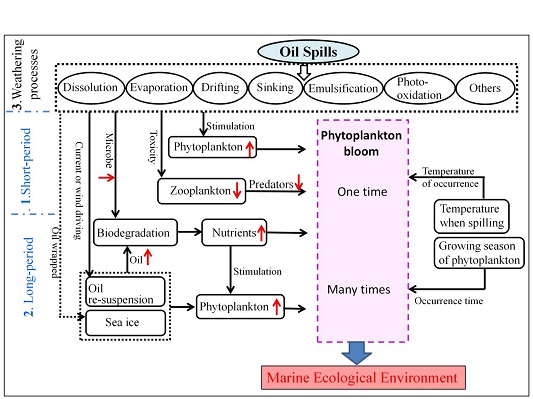科研动态
研究进展丨基于卫星遥感研究浮游植物对海洋溢油的生态响应
近日,中国科学院南海海洋研究所、热带海洋环境国家重点实验室、广东省海洋遥感重点实验室(LORS)唐丹玲研究团队的论文《Ecological Response of Phytoplankton to the Oil Spills in the Oceans》在SCI 期刊《Geomatics, Natural Hazards and Risk》发表。

据联合国有关组织统计,每年由于人类活动而流入海洋的石油约1000万吨,其中海上油井井喷事故和油轮事故造成的溢油高达220万吨。海洋溢油对海洋生态环境的影响引起广泛高度重视。唐丹玲领导的海洋生态遥感团队多年来致力于南海溢油的监测和生态响应研究,取得成果。
研究利用MODIS (Moderate Resolution Imaging Spectroradiomerer ) 卫星和历史资料数据统计分析了全球20次重要的溢油事件后CHL-a的变化和浮游植物藻华的爆发情况,结果发现,20次溢油中,有14溢油次引发藻华。所有14次藻华发生, 72%出现在(20 - 30?C)时, 7%出现(10 - 20?C)时,21%发生在(<10?C)。


研究提出了海洋溢油引发藻华概念模型,阐述溢油对海洋生态环境的影响,包括短时间和长时间。海洋浮游动物是海洋食物链中的主要环节,在海洋生态系中对物质循环和能量流动、海域生物生产力及其调节机制都起着不可忽视的作用。溢油后,浮游动物对石油类的敏感性较高。另外,溢油发生时大部分溢油浮于水面并扩散成油膜,阻碍海水与大气之间的物质交流和热交换,使得海水中的溶解氧浓度降低,导致部分浮游动物窒息死亡。结果在溢油后,一周内浮游植物,缺少捕食者,会大规模爆发引发。溢油后,石油在风场和流场等的作用下,经过扩散、漂移、下沉等,进入海洋底部和周围海区,甚至远距离区域。经过复杂的生物化学变化,释放出营养物质,这些物质被浮游植物吸收然后促进了浮游植物的生长。石油分解的时间可以持续长时间,这个时间过程是3-10个月,在有些高纬度地区,由于冰冻延长效应使得这个时间更长,甚至是一年。研究发现,如果石油释放出营养物质的时间是夏季或热带海区,在夏季光照条件充足,在20-30 oC的温度条件下,光合作用等生物化学作用强,发生藻华的机率更高。

ABSTRACT: Oil spills in oceans have substantial influence on marine ecosystems. This study investigates 21 oil spills in the world. Analyzing Chlorophyll-a (Chl-a) from Moderate Resolution Imaging Spectroradiomerer (MODIS) data after Penglai oil spills on 4 June 2011, found a bloom with peak value of Chl-a (13.66 mg m3 ) spread over an area of 800 km2 during 18–25 June 2011, and a pronounced increase in the monthly Chl-a concentration (6.40 mg m3 ) on June 2012 in the Bohai Sea. Out of the 21 oil spills, 14 blooms were observed, while 11 blooms associated with oil spills in the time interval of 3–10 months. In total, about 75% blooms occurred during June–August. Among all 14 blooms, 72% appeared when temperature was warm (20–30 C), 7% appeared when temperature was low (10–20 C), and the remaining 21% occurred when temperature was lower than 10 C. This research concludes that the odds of a phytoplankton bloom after an oil spillage are higher at the time of higher temperature (>20 C). The short-term impact of the oil spills on ecosystem could mainly depend on the quantity and composition of oil, while the longterm impact of the oil spills on ecosystem could be related to biodegradation of microorganisms.
资助:中国石油化工股份有限公司合作研究项目(原油远洋运输优化与遥感监测技术研究:313099,2013-2015),国家自然科学基金项目(41430968,41876136)。
Danling Tang, Jing Sun, Li Zhou, Sufen Wang, Ramesh P. Singh and Gang Pan,2018.Ecological response of phytoplankton to the oil spills in the oceans,Geomatics, Natural Hazards and Risk。PDF全文见: https://doi.org./10.1080/19475705.2018.1549110 和 http://www.lingzis.com/journal%20article.htm。
相关研究论文:
1. Sun J,Tang DL *. RADARSAT-2 satellite remote sensing of oil spills near Hainan Island using quad-polarization data,Indian Journal of Geo Marine Sciences.
2. 孙景,唐丹玲*,潘刚.Radarsat2 全极化数据在监测南海溢油事件中的方法研究.遥感技术与应用, 2016, 31(6)pp1181-1189
3. 周利,唐丹玲*,孙景.海洋溢油后浮游植物藻华观测分析和机制探讨. 生态科学, 2013, 32 (6) pp 692-702
